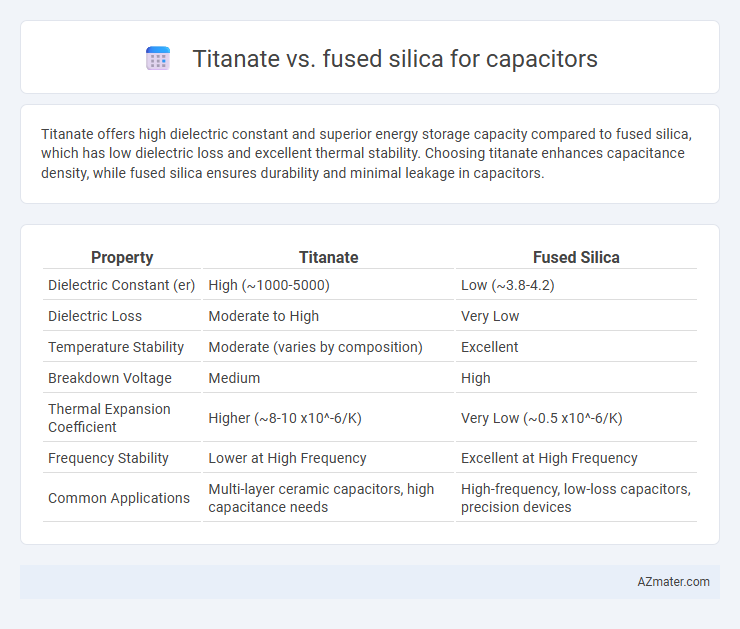Titanate offers high dielectric constant and superior energy storage capacity compared to fused silica, which has low dielectric loss and excellent thermal stability. Choosing titanate enhances capacitance density, while fused silica ensures durability and minimal leakage in capacitors.
Table of Comparison
| Property | Titanate | Fused Silica |
|---|---|---|
| Dielectric Constant (er) | High (~1000-5000) | Low (~3.8-4.2) |
| Dielectric Loss | Moderate to High | Very Low |
| Temperature Stability | Moderate (varies by composition) | Excellent |
| Breakdown Voltage | Medium | High |
| Thermal Expansion Coefficient | Higher (~8-10 x10^-6/K) | Very Low (~0.5 x10^-6/K) |
| Frequency Stability | Lower at High Frequency | Excellent at High Frequency |
| Common Applications | Multi-layer ceramic capacitors, high capacitance needs | High-frequency, low-loss capacitors, precision devices |
Introduction to Capacitor Dielectrics
Titanate and fused silica serve as distinct capacitor dielectric materials, with titanate offering high dielectric constants for enhanced capacitance in compact designs, whereas fused silica provides exceptional thermal stability and low dielectric loss for high-frequency applications. Titanate dielectrics are commonly employed in multilayer ceramic capacitors (MLCC) due to their tunable permittivity and energy storage capabilities. Fused silica, characterized by its superior insulation resistance and minimal temperature dependence, is ideal for precision capacitors requiring consistent performance under varying environmental conditions.
Overview of Titanate Materials
Titanate materials, such as barium titanate, are widely used in capacitors due to their high dielectric constant and excellent temperature stability, enabling compact designs with enhanced energy storage capabilities. Compared to fused silica, titanates offer superior permittivity, which translates to higher capacitance values in smaller volumes, making them ideal for multilayer ceramic capacitors (MLCCs). Their ferroelectric properties provide reliable performance in varying electrical and thermal environments, distinguishing titanate-based capacitors in advanced electronic applications.
Overview of Fused Silica Materials
Fused silica is a high-purity, non-crystalline form of silicon dioxide with exceptional thermal stability and low dielectric loss, making it ideal for capacitor substrates requiring high-frequency performance. Its low thermal expansion coefficient reduces mechanical stress and enhances reliability in capacitors operating under varying temperature conditions. Compared to titanate materials, fused silica offers superior insulation properties and minimal dielectric absorption, crucial for precision electronic applications.
Key Electrical Properties Comparison
Titanate capacitors exhibit high dielectric constant and excellent temperature stability, making them ideal for applications requiring high capacitance in a compact form. Fused silica capacitors offer superior electrical insulation, ultra-low dielectric loss, and exceptional voltage strength, which are critical for high-frequency and high-voltage applications. Comparing key electrical properties, titanate capacitors provide higher capacitance density, whereas fused silica capacitors excel in low dissipation factor and increased dielectric breakdown voltage.
Dielectric Constant: Titanate vs Fused Silica
Titanate materials exhibit a significantly higher dielectric constant, often ranging from 100 to over 10,000, making them suitable for high-capacitance capacitor applications. In contrast, fused silica has an ultra-low dielectric constant around 3.8 to 4.0, which limits its use in capacitors requiring high energy storage but offers advantages in high-frequency and low-loss applications. The superior dielectric constant of titanate directly translates to greater capacitance in a smaller volume compared to fused silica.
Temperature Stability Differences
Titanate capacitors exhibit excellent dielectric constant but have limited temperature stability, with capacitance variation typically ranging from +-15% to +-30% over -55degC to 125degC. Fused silica capacitors provide superior temperature stability, maintaining capacitance variation within +-2% to +-5% across similar temperature ranges due to their low thermal expansion and minimal dielectric loss. The choice between titanate and fused silica capacitors hinges on temperature sensitivity requirements, where fused silica is preferred in precision applications demanding minimal capacitance drift.
Frequency Response Analysis
Titanate capacitors exhibit higher dielectric constants, resulting in superior capacitance at low frequencies but suffer from increased dielectric losses and reduced frequency stability compared to fused silica capacitors. Fused silica capacitors demonstrate exceptional frequency response with minimal dielectric relaxation, making them ideal for high-frequency applications up to GHz ranges due to their low loss tangent and stable permittivity. Frequency response analysis confirms that fused silica capacitors maintain consistent impedance and phase angle across wide frequency spectra, outperforming titanate counterparts in RF and microwave circuit performance.
Manufacturing and Cost Considerations
Titanate capacitors, often utilizing barium titanate, offer high permittivity enabling compact designs but involve complex ceramic processing that increases manufacturing costs compared to fused silica capacitors. Fused silica, prized for its thermal stability and low dielectric loss, requires specialized high-purity silica processing which can elevate production expenses despite simpler fabrication techniques. Cost considerations favor titanate in applications demanding higher capacitance per volume, while fused silica suits environments prioritizing stability and low dielectric loss despite higher material expenses.
Typical Applications in Electronics
Titanate materials are widely used in ceramic capacitors due to their high dielectric constant, enabling compact and high-capacitance components ideal for filtering and decoupling in consumer electronics and automotive applications. Fused silica offers exceptional thermal stability and low dielectric loss, making it suitable for high-frequency and precision applications such as RF circuits and aerospace electronics. The choice between titanate and fused silica capacitors depends on balancing dielectric properties, temperature stability, and frequency response tailored to specific electronic device requirements.
Choosing the Right Dielectric for Your Capacitor
Titanate offers high dielectric constant and excellent temperature stability, making it ideal for capacitors requiring high capacitance in compact sizes, especially in MLCC applications. Fused silica provides ultra-low dielectric loss and exceptional thermal stability, suitable for high-frequency and precision capacitor applications where minimal signal distortion is critical. Selecting the right dielectric depends on balancing capacitance requirements, temperature behavior, and electrical performance to optimize capacitor efficiency and reliability.

Infographic: Titanate vs Fused silica for Capacitor
 azmater.com
azmater.com